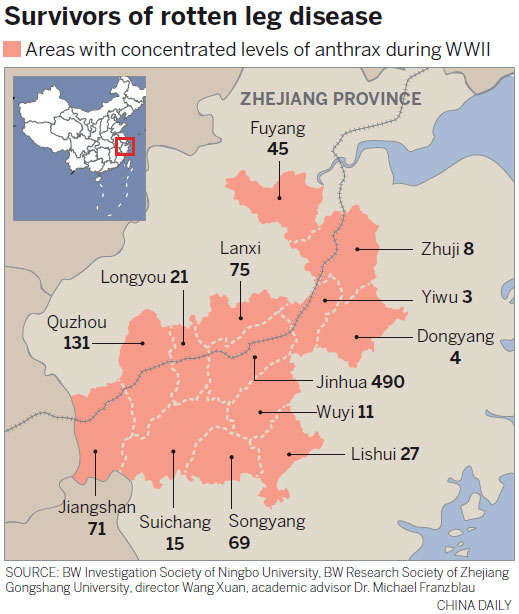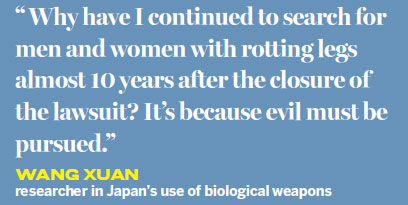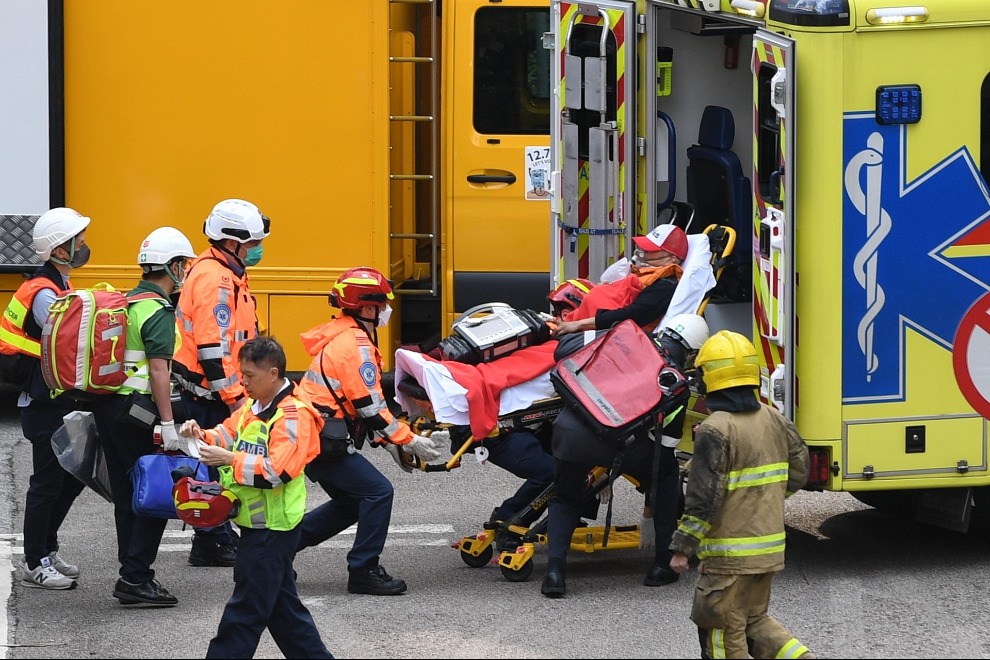The long fight for justice

One woman has spent decades battling to win compensation for victims of Unit 731, the Japanese army's notorious germ warfare division
"The Japanese really did it," Wang Xuan says, recalling her initial reaction when she discovered a crucial piece of evidence in a file at the National Archives and Records Administration in Washington in 2003.
Wang is one of China's leading researchers into Japan's use of biological weapons during World War II. The file she came across contained the testimony of Tomosada Masuda, a former colonel in the Japanese Medical Corps and head of the second Section of Unit 731, the Japanese Imperial Army's notorious biological and chemical warfare research and development unit.
Masuda's postwar confession came during an investigation conducted by Norbert H. Fell, a high-profile US investigator, with Japanese diplomat Kanichiro Kamei acting as the interpreter.
"There is no question that BW (biological weapons) trials were made against the Chinese army in Central China. The bombs were originally developed as a means of developing defensive measures against possible BW on the part of an enemy," Masuda said during the interview.
"However, the strong offensive value of BW bombs, particularly if loaded with anthrax, was soon apparent."
The moment Wang saw the word "anthrax", her eyes opened wide. The 64-year-old Shanghai resident had spent two decades looking into the possible use of the bacteria by Japanese troops during WWII.
"I had talked to many elderly men and women with rotten legs in the provinces of Zhejiang and Jiangxi," she says. "The information we gathered, from the symptoms of the disease at its various stages to the time and scale of its outbreak, all pointed to an unnatural cause, most probably Japanese BW warfare. But still, we needed to prove it.
"The Central China mentioned in Masuda's testimony refers exactly to the areas of Zhejiang and Jiangxi where the Japanese launched a campaign between May and August 1942," she adds.
Between 1997 and 2007, Wang led China's largest plaintiffs' group - with 180 members, including herself - in a lawsuit against the Japanese government. The members were victims or relatives of victims of Japan's use of germ warfare. The use of anthrax, though, was not included in the list of complaints.
Her research into anthrax attacks and the protracted court proceedings made Wang - whose late father was the first president of the Shanghai Bar Association - even more aware of the importance of the evidence.
"The initial shock and pain guided my investigations into this disease from history," she says.
One challenge lies in the fact that traditional medical methods have yet to find evidence of anthrax in the victims' wounds. However, that's natural, according to Martin Furmanski, a medical scientist and historian from the United States.
"These wounds have remained open and draining since 1942. There have certainly been many opportunities for other bacteria to be introduced and become part of a devil's brew of mixed bacteria," he wrote in an email to China Daily.
"Lack of circulation can cause ulcers on its own. For a man with rotten legs, anthrax infection more than 70 years ago set off a chain effect, long after the bacteria itself had disappeared," she said.
The outbreak of rotten legs in Zhejiang and Jiangxi coincided exactly with the Japanese campaign in the provinces, and the villages that suffered most were those located either along the Zhejiang-Jiangxi Railway or nearby air bases and fields.
One example is Jiangshan county in Zhejiang. On April 18, 1942, a number of US pilots crashed in the county after conducting an air raid over Japan's larger cities. They were rescued by local people.
"Right after the Zhejiang-Jiangxi campaign, the Jiangshan county government conducted a survey into war damages and found numerous cases of rotting legs and bodies," Wang says.
"Of all the towns in the area, Dachen suffered the most: More than 5,000 villagers were found to have rotting patches of skin, and more than 3,000 had rotting legs," she says.
Through her research over the past two decades, Wang has met many Japanese historians of WWII, especially those focused on germ warfare. One of them was Shoji Kondo, who interviewed about 300 veterans of the Japanese army, including many associated with its biological weapons programs.
"The testimonies show that experiments to test the effectiveness of anthrax bombs were conducted on humans at the unit's headquarters in Harbin in Northeast China," Wang says. "The subjects were tied to stakes while bombs containing the anthrax bacteria exploded in the air above their heads. The numerous tiny shards spread by the blasts were expected to cut through the skin to cause anthrax infection."
Despite the efforts of scientists and researchers around the world, Wang says there is still much to be done before an assertion can be made in legal terms that the rotting flesh was a result of the Japanese anthrax attack.
"What I'm doing right now is building a database of similar cases during the war. And I'm also hoping the Japanese government will release more documents about Japan's wartime BW program," she says.
Between 1997 and 2007, Wang and other plaintiffs took their lawsuit from a district court in Japan to higher courts and finally the Supreme Court. Their appeals for compensation were rejected. Yet while ruling that the Chinese victims did not have the right to demand compensation from Japan, the higher courts did uphold the lower court verdict acknowledging, for the first time, that the Japanese had used biological weapons against Chinese civilians.
"Why have I gone to the courts more than 40 times? And why have I continued to search for men and women with rotting legs almost 10 years after the closure of the lawsuit?" Wang says. "It's because evil must be pursued."


(China Daily European Weekly 07/15/2016 page16)
Today's Top News
- Xi calls for promoting volunteer spirit to serve national rejuvenation
- Xi chairs CPC meeting to review report on central discipline inspection
- Reunification will only make Taiwan better
- Outline of Xi's thought on strengthening military published
- Targeted action plan to unleash consumption momentum
- Separatist plans of Lai slammed






























